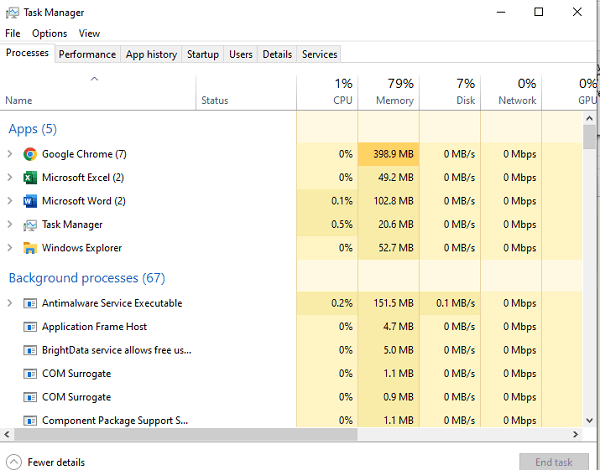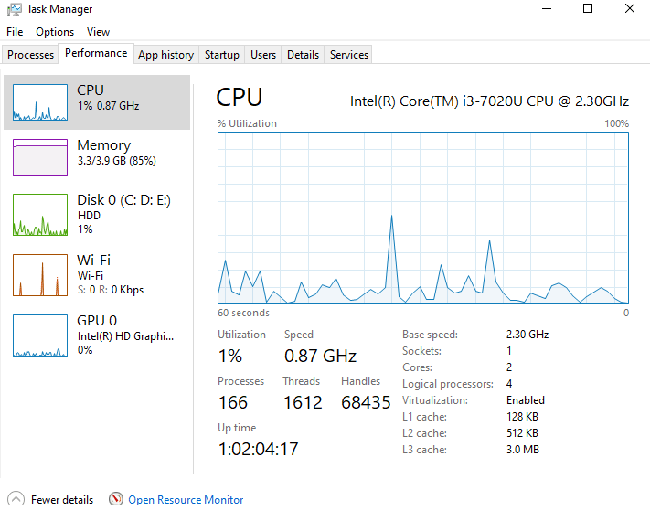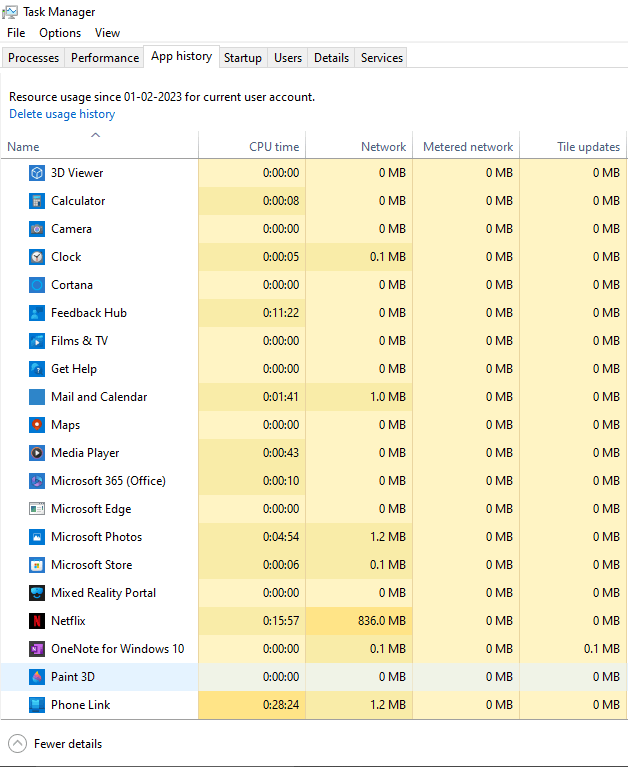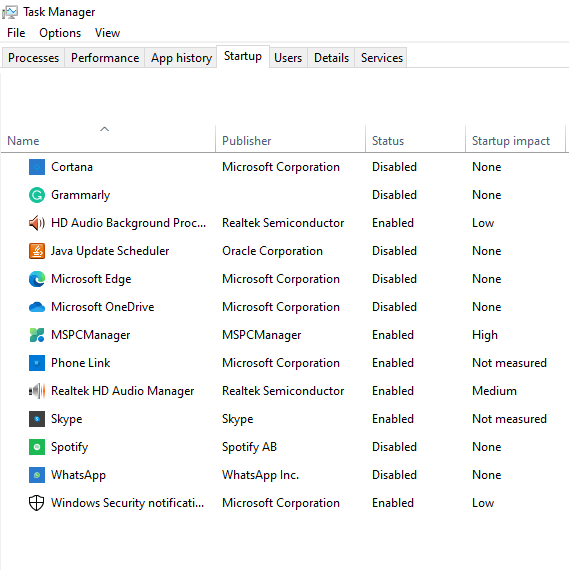What is Task Manager?
Task Manager is a system tool in Microsoft Windows and other operating systems that provides information about the processes and system performance running on a computer. It allows users to view and manage running processes, monitor system performance, and allocate resources. Task Manager provides information such as process names, users who started the processes, CPU, and memory usage, and allows ending unneeded processes. Additionally, it can display system performance information, such as CPU utilization, memory usage, and network activity, and also provides a list of startup programs that can be enabled or disabled. Task Manager is a valuable tool for casual users and IT professionals to manage and optimize their computer performance.
Uses of Task Manager
Task Manager has several uses, including:
- Viewing and Managing Running Processes: Task Manager lists all running processes and their details, allowing users to end processes that are not responding or taking up too many resources.
- Monitoring System Performance: Task Manager displays important system performance information, such as CPU utilization, memory usage, and network activity, which can help diagnose performance issues.
- Managing Startup Programs: Task Manager displays a list of programs that start when the computer boots and allows users to enable or disable them as needed.
- Setting Process Priority: Task Manager allows users to adjust the priority of processes, which can help allocate system resources more effectively.
- Monitoring and Managing Resource usage: Task Manager provides real-time information about resource usage, making it easy to identify processes using too much CPU, memory, or network resources.
- Troubleshooting Performance Issues: Task Manager's performance graphs and detailed process information can help diagnose and resolve performance issues.
- Monitoring GPU Utilization and Performance: In recent versions of Windows, Task Manager also includes a tab for GPU utilization and performance, which is especially useful for users with high-end graphics cards.
- To Terminate Ongoing Programme: The task Manager can also close or Terminate a program instead of restarting the whole computer. This is one of the most frequently used features of the Task Manager.
In summary, Task Manager is a versatile tool that can be used for managing processes, monitoring system performance, and troubleshooting performance issues. It is an essential tool for optimizing computer performance.
Ways to open Task Manager
There are several ways to open Task Manager in Windows, Such as:
- Keyboard Shortcut: The "Ctrl + Shift + Esc" keyboard shortcut is the fastest/easiest and most direct way to open Task Manager. This universal shortcut works on all Windows versions and can be used even if the computer is not responding.
- Right-Click on Taskbar: Right-clicking on the taskbar and selecting "Task Manager" from the context menu is another simple way to open Task Manager. This method is available in all versions of Windows and can be used even if the computer is not responding.
- Run Command: The Run command is a feature in Windows that allows you to open applications and system tools quickly. To open Task Manager using the Run command, press the "Windows + R" keys to open the Run dialogue box, then type "taskmgr" and press "Enter."
- Windows Search: The Windows search feature lets you quickly find files, folders, and system tools on your computer. To open Task Manager using Windows search, click the Start button and type "Task Manager" in the search box. Click on the result to open Task Manager.
- Command Prompt: The Command Prompt or CMD in Windows is a text-based interface that allows you to run commands and execute scripts. To open Task Manager using the Command Prompt, open Command Prompt, type "taskmgr," and press "Enter."
- PowerShell: PowerShell is a powerful command-line interface in Windows that allows you to run commands and execute scripts. To open Task Manager using PowerShell, open PowerShell, type "taskmgr," and press "Enter."
- Windows Security: In recent versions of Windows, Task Manager can be opened through the Windows Security feature. To open Task Manager this way, click the Start button and select "Settings" > "Update & Security." Under "Windows Security," click "Open Windows Defender Security Center," then click "Device performance & health", and finally click "Open Task Manager."
These are the seven most common ways to open Task Manager on Windows. How you choose will depend on your preference and the version of Windows you are using.
Different Tabs in Task Manager
Processes Tab
The Processes tab in Task Manager lists all active processes on the computer and important information about each process. This information can monitor system performance, diagnose performance issues, and manage running processes.
Data Shown for each process:
- Process Name: The name of the process is displayed in the Name column. This can help you identify the purpose of the process and whether it is legitimate or malicious.
- Status: The status column displays whether the process is running or suspended.
- CPU Usage: This column displays the percentage of CPU utilization by the process. A high CPU usage percentage can indicate that the process uses too many resources and may be causing performance issues.
- Memory Usage: This column displays the process's memory in MB or GB. High memory usage means the process takes many loads on the system’s memory.
- Description: This column displays a description of the process. This can help you identify the purpose of the process and whether it is legitimate or malicious.
- End Task Button: The End Task button can force a process to close if it is not responding. This can be useful if a process is causing performance issues or if you want to free up resources used by the process.

The Processes tab in Task Manager is a powerful tool for monitoring system performance and managing running processes. By understanding the information displayed for each process, you can diagnose performance issues and take action to improve system performance.
Performance
The Performance tab in Task Manager provides real-time information about the system performance, including CPU utilization, memory usage, and complex drive activity. This information can be used to monitor system performance, diagnose performance issues, and optimize computer performance.
Here is a brief explanation of the information displayed in the Performance tab:
- CPU Usage: This section also displays the current CPU utilization in percentage form. It displays the number of logical processors in the computer.
- Memory Usage: This section also displays the current memory usage in MB / GB. It also displays the total amount of physical memory installed on the computer.
- Hard Drive Activity: This section displays the current disk activity, including the disk utilization and the number of reads and writes per second. A high disk utilization can indicate that the computer is running too many disk-intensive processes or that a single process uses too much disk space.

The Performance tab in Task Manager is a valuable tool for monitoring system performance and diagnosing performance issues. By understanding the information in this tab, you can optimize computer performance and ensure your computer runs smoothly.
App History
The App History tab in Task Manager provides information about the resource utilization of Windows Store apps that have been run on the computer. This information can be used to monitor the performance of Windows Store apps and determine which apps are using too many resources.
All the information displayed in the App History tab:
- App Name: This column displays the name of the Windows Store app.
- CPU Time: This column displays the amount of CPU time the app uses. A high CPU time can indicate that the app uses too many resources.
- Network: This column displays the amount of network data the app uses. A high network usage can indicate that the app uses too much bandwidth.
- Metered Network: This column displays the amount of metered network data the app uses. This data determines whether an app uses too much bandwidth, such as a cellular data connection, on a metered network.
- Tile Updates: This column displays the number of tile updates performed by the app. Many tile updates can indicate that the app needs to use more resources.

The App History tab in Task Manager is a valuable tool for monitoring the performance of Windows Store apps and ensuring that they are using only a few resources. By understanding the information displayed in this tab, you can optimize the performance of Windows Store apps and ensure that your computer is running smoothly.
Startup Tab
The Startup tab in Task Manager provides information about the programs and applications set to run automatically when the computer starts. This information can be used to manage startup programs and improve the performance and speed of the computer.
Information stored in the Startup tab:
- Name: This column shows the name of the startup program.
- Publisher: This column displays the publisher of the startup program.
- Startup impact: This column displays the impact that the startup program has on the startup performance of the computer. A high impact indicates that the startup program uses many resources and slows the startup process.
- Status: This column displays the current status of the startup program, such as enabled or disabled.
- Disable Button: This button can be used to disable the startup program. Disabling a startup program can improve the startup performance of the computer and free up resources.

The Startup tab in Task Manager is a useful tool for managing startup programs and improving the performance and speed of the computer. By understanding the information displayed in this tab, you can control which programs and applications are set to run automatically and optimize the startup performance of your computer.
Users Tab
The Users tab in Task Manager displays information about the user accounts currently logged on to the computer and the processes they are running. This information can be used to manage and monitor the processes running on the computer and manage user accounts.
Here is an explanation of the information displayed in the Users tab:
- User Name: This column displays the user account's name currently logged on to the computer.
- Status: This column displays the user account status, such as active or disconnected.
- Session ID: This column displays a unique ID number assigned to each user session.
- Processes: This column displays the number of processes under the user account.
- CPU Usage: This column displays the number of CPU resources used by the processes running under the user account.
- Memory Usage: This column displays the number of memory resources used by the processes running under the user account.

The Users tab in Task Manager is a useful tool for managing and monitoring the processes running on the computer and managing user accounts. By understanding the information displayed in this tab, you can ensure that the computer runs smoothly and that user accounts are used appropriately.
The Details Tab
The Details tab in Task Manager provides detailed information about the processes running on the computer. This information can be used to monitor the computer's performance and troubleshoot issues with running processes.
Here is a brief explanation of the information displayed in the Details tab:
- Name: This column shows the name of the process.
- PID (Process ID): This column displays a unique ID number assigned to each process.
- CPU: This column also displays the percentage of CPU resources the process uses.
- Memory (Private Working Set): This column displays the process's number of memory resources.
- Disk: This column displays the process's number of disk resources.
- Description: This column describes the process, including information about the publisher and the product name.
- User Name: This column displays the user account's name running the process.
- Session ID: This column displays the ID number of the user session running the process.
The Details tab in Task Manager is a useful tool for managing and monitoring the performance of the computer and troubleshooting issues with running processes. By understanding the information displayed in this tab, you can ensure that the computer runs smoothly and processes are used appropriately.
Service Tab
The Services tab in Task Manager provides information about the services running on the computer. Services are background processes that provide specific functions, such as printing, file sharing, or security updates. This information can be used to manage and monitor the services running on the computer.
Here is a brief explanation of the information displayed in the Services tab:
- Name: This column shows the name of the service.
- Description: This column displays a service description, including information about the publisher and the product name.
- Status: This column displays the current status of the service, such as running or stopped.
- Startup Type: This column displays the service's startup type, such as automatic or manual.
- Log On As: This column displays the user account that the service is set to run under.
- Process Name: This column displays the process's name associated with the service.
- PID (Process ID): This column displays a unique ID number assigned to the process associated with the service.
The Services tab is a useful tool for managing and monitoring the services running on the computer. By understanding the information in this tab, you can ensure that the services critical to the computer's functioning are running smoothly and that any service issues can be addressed promptly.